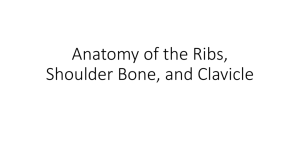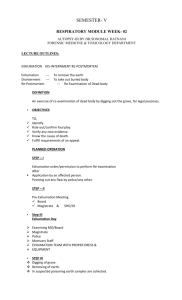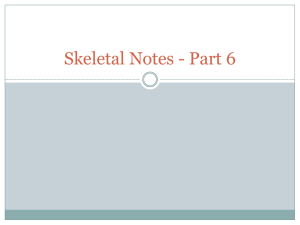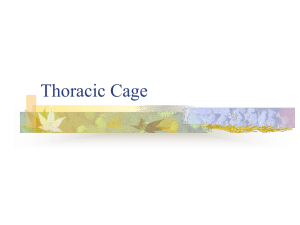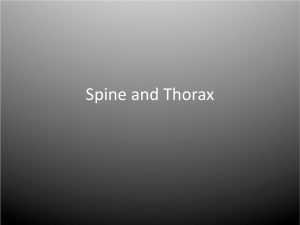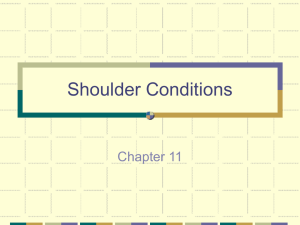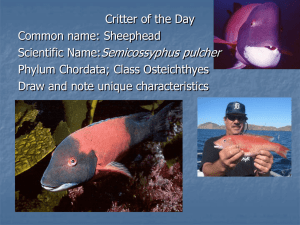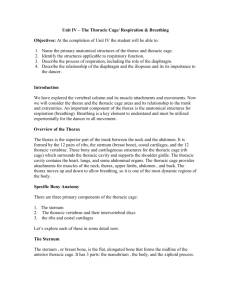Bony Thorax ( RIBS) - Amazon Web Services
advertisement
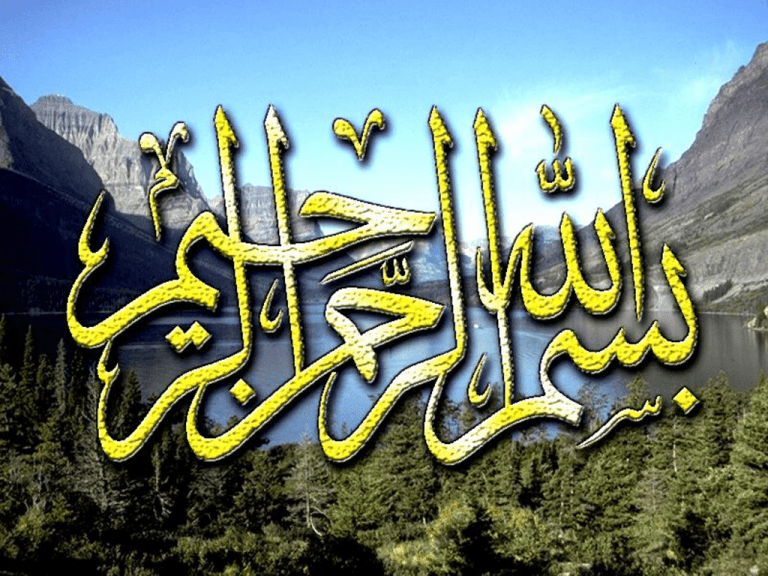
Radiographic Anatomy Skeletal System Bony Thorax & shoulder Girdle Educational Objectives By the end of this lecture you should be able to: Identify the anatomical parts of bony thorax on diagrams and radiographs. Identify the different joints of bony thorax and classify their type of movement. State the surface land marks of bony thorax and explain its importance in radiographic positioning Explain how to hang radiographs of bony thorax on the view box References 1. Text book of radiographic positioning and related anatomy; by Kenneth L.Bontrager,6th edition. 2. Introduction to Human Anatomy and Physiology: by Eldra Pearl Solomon:W.B.Saunders Company 3. Handbook of Anatomy and physiology for Students of Medical Radiation Technology: Mallett.M:Jaspar Websites http://www6.district125.k12.il.us/science/anatomy/ http://www.innerbody.com/htm/body.html http://www.e-radiography.net/ http://www.getbodysmart.com/index.htm 4 Outlines ( Bony Thorax) ■ Sternum: anterior ■ Thoracic vertebrae: posterior ■ Ribs (12 pairs) : connecting Bony Thorax ( Sternum) Flat bone with three divisions • Manubrium: • Upper portion • 2 inches • Indentations (jugular, clavicular, costal) • Body: • Middle portion • 5 inches • Costal notches • Xiphoid process: • Lower portion • Small • Vary in size and shape Bony Thorax ( RIBS) 1. Vertebral end: posterior • Head: articulate with body of Thoracic vertebra • Neck: • Tubercle: articulate with Trans.Process.1 2 2. Shaft: lateral forward downward • Costal Angle: • Costal groove: artery, vein, nerve 3. Sternal end: anterior • 3 to 5 inches lower than vertebral end The rib cage is part of the axial skeleton and assist in breathing as well as protect internal organs. 3 Bony Thorax ( RIBS) The rib cage is part of the axial skeleton Assist in Breathing Protect internal organs. Bony Thorax ( RIBS) Elongated, flattened, and twisted bones Sternum Sternum Sternal end Ribs Costal Cartilage Head Body Vertebra Costal Cartilage Angle Vertebral end Bony Thorax ( RIBS) Sternum Sternum Sternal end Ribs Costal Cartilage Head Body Vertebra Vertebra Angle Vertebral end Bony Thorax ( RIBS) 1. Ribs 2. Clavicle 3. Sternum superimposed over heart and Vertebrae 1 2 2 3 Shoulder Girdle( Clavicles & Scapulae) The pectoral girdle- consist of the scapula and clavicle, attaches upper limbs to axial skeleton, and provides attachment sites for muscles A. Clavicles-also called the collarbone, they are long bones. B. Scapulae-also called shoulder-blades, they are flat bones with three borders. Scapula Clavicle Shoulder Girdle Shoulder or Pectoral Girdle Clavicle- attaches to sternum and scapula Scapula Acromion Processes Coracoid processes Glenoid cavity- holds humeral head Shoulder Joint The glenohumeral joint Articulation between the humeral head and the Glenoid fossa of the scapula The glenohumeral joint is a balland-socket joint that allows for the arm to move in a circular rotation as well as movement of the arm towards and away from the body. The acromio clavicular joint Articulation between the lateral end of the clavicle and the Acromion process of the scapula A.C Joint glenohumeral joint Shoulder Joint Shoulder Joint Shoulder Joint 1. Clavicle 2. Acromioclavicular joint 3. Acromion 4. Greater tubercle of humerus 5. Head of humerus 6. Lesser tubercle of humerus 7. Surgical neck of humerus 8. Coracoid process 9. Glenoid fossa 10. Shoulder joint 11. Lateral border of scapula AP Shoulder THANK YOU
